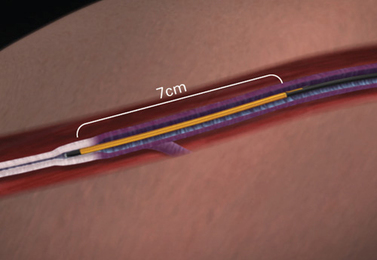Endovenous Radiofrequency Ablation
We are pleased to offer the endovenous radiofrequency ablation procedure, in addition to other treatment modalities for comprehensive mangement of vein disease. This prodedure is a minimally invasive treatment alternative for patients with a condition known as superficial venous reflux, which often results in varicose veins and other painful symptoms. Approximately 25 million people in the U.S. suffer from superficial venous reflux. The endogenous radio frequency ablation procedure has replace traditional vein stripping surgery, and brings state-of-the-art technology to an old disease.
Frequently Answered Questions
What happens during the procedure and how is it performed?
The Endovenous Radiofrequency Ablation procedure is an outpatient office-based procedure. Local, tumescent anesthesia is used to numb the treatment area. A thin catheter is inserted into the vein through a puncture site using only a needle stick. The catheter delivers radiofrequency (RF) energy to the vein wall, causing it to heat, collapse and seal shut. Once the diseased vein is closed, other healthy veins take over and empty blood from your legs. As normal return flow is re-established, your symptoms should improve noticeably.
What happens after the procedure?
Following the procedure, the catheter is removed and a dressing is applied over the puncture site. You will then be placed into graduated compression stockings. Many patients resume normal activity except that they will need to wear their compression stockings to improve the results of treatment.
Why is radiofrequency ablation better than vein stripping?
Both vein stripping and radiofrequency ablation accomplish the same thing: to eliminate venous reflux through the superficial veins. Radiofrequency ablation uses heat to close (seal) the vein shut. Vein stripping accomplishes the same thing, however, there is a much higher chance of pain, bleeding, nerve injury and bruising from stripping the vein, rather than closing it.
What are the risks associated with this procedure?
Potential Risks & Complications:
▪ Potential complications include, but are not limited to the following: vessel perforation, heat-induced thrombosis, phlebitis, hematoma, infection. These complications are very rare.
▪ Treatment of veins located very close to the skin surface may result in a skin burn.
▪ Paresthesia (nerve injery) may occur from the thermal damage to adjacent sensory nerves. The risk of paresthesia is higher with treatment at or below the calf.
What happens during the procedure and how is it performed?
The Endovenous Radiofrequency Ablation procedure is an outpatient office-based procedure. Local, tumescent anesthesia is used to numb the treatment area. A thin catheter is inserted into the vein through a puncture site using only a needle stick. The catheter delivers radiofrequency (RF) energy to the vein wall, causing it to heat, collapse and seal shut. Once the diseased vein is closed, other healthy veins take over and empty blood from your legs. As normal return flow is re-established, your symptoms should improve noticeably.
What happens after the procedure?
Following the procedure, the catheter is removed and a dressing is applied over the puncture site. You will then be placed into graduated compression stockings. Many patients resume normal activity except that they will need to wear their compression stockings to improve the results of treatment.
Why is radiofrequency ablation better than vein stripping?
Both vein stripping and radiofrequency ablation accomplish the same thing: to eliminate venous reflux through the superficial veins. Radiofrequency ablation uses heat to close (seal) the vein shut. Vein stripping accomplishes the same thing, however, there is a much higher chance of pain, bleeding, nerve injury and bruising from stripping the vein, rather than closing it.
What are the risks associated with this procedure?
Potential Risks & Complications:
▪ Potential complications include, but are not limited to the following: vessel perforation, heat-induced thrombosis, phlebitis, hematoma, infection. These complications are very rare.
▪ Treatment of veins located very close to the skin surface may result in a skin burn.
▪ Paresthesia (nerve injery) may occur from the thermal damage to adjacent sensory nerves. The risk of paresthesia is higher with treatment at or below the calf.

